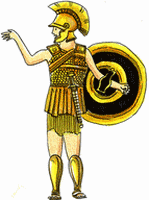Maps of the Antique
Mediterranean Sea
 Greece Greece
 Attic Attic
 Corinth Corinth
 Magna Graecia Magna Graecia
 Apulia Apulia
 Daunia Daunia
 Gnathia Gnathia
 Campania Campania
 Some dates Some dates
 Archaeological sites Archaeological sites
 Pottery and ceramics Pottery and ceramics

|
CAMPANIA

|
Towards 1000 B.C., Italy is inhabited by a mosaic of peoples of Indo-european origin like the Samnites, the Latins, the Ombrians, Opiques or Ausones, Aurunces, etc.
By the 8th century B.C.,
following an important increase of their population, many greeks leaved to found new cities around the Mediterranean sea. South of Italy and Sicily, because of the geographical proximity and of their agricultural prosperity, were important settlement places.
| Cumes, founded ca. 750-740 B.C., is sometimes regarded as the oldest Greek colony in the western word. The Greeks will found other important cities in Campania, like Paestum towards 600, Elea (today Velia) ca. 540-535, Napoli (Neapolis, the "new city", since Cumes have become the "old city"), Pouzzole, etc.
On their side, the Etruscans, coming from north, occupy Campania by the 6th century B.C., for trading reasons and also for less friendly raids. However they avoid the Greek cities like Cumes, already well established. On their way, they found Capua (Campeva) then Nola, Pompei, Sorrente, Herculanum. The cohabitation with the Greeks was sometimes stormy, but by 424 B.C., the rich cities, Greek or Etruscan, are frequently attacked by mountain tribes, like the Samnites, against which the Romans will have to fight for a long time. Regarding the Aurunces, the Romans will defeat them definitively only in 313 B.C. Their capital, Cales (today Calvi Risorta), became then the center of the Roman domination in Campania, and played during the two following centuries an important economic role thanks to its ceramics production (“calene ware”).
Indeed, since the defeat of Athens in the Peloponnesian War in 404 B.C., many greek artists and craftsmen had emigrated in Magna Graecia, whose cities had took over the production (after 320 B.C., Athens produces only few vases - of great value however - like the prices intended to reward the athletes in the panathenaic games). The cities of Magna Graecia conquer the market. Campanian potteries, particularly those of Teano and Cales, are in open competition with those of the nearby apulian city of Canosa.
In 292 B.C., the Romans occupy Campania, and then all southern Italy. The history of the Campania merges then with that of Rome. The rich Romans cover Campania with splendid villas. But the system of the latifundia (large farms) introduced in the 2nd century B.C. ruins the province. This explains the achievements of Spartacus in this area, in 73 B.C. Then will come the eruption of the Vesuvius…
|
|

















